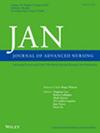Nurse Roles Implementing the Choice for Self-Collection Cervical Screening in Rural Settings: A Qualitative Study Following National Policy Change.
IF 3.4
3区 医学
Q1 NURSING
引用次数: 0
Abstract
AIM To explore the key factors influencing nurses' capability, opportunity and motivation to offer the choice for self-collection for cervical screening within rural primary care services, following a national policy change in Australia. DESIGN A qualitative study informed by implementation and behavioural change frameworks. METHODS Primary health nurses working in Victoria were invited to participate in semi-structured interviews via video or telephone between December 2022 and March 2023. Eighteen nurses from 18 clinics participated. Interview data were analysed following a Framework analysis approach, and themes were mapped to the COM-B model. RESULTS Nurses were highly motivated to offer the choice for self-collection due to perceived advantages for their patients and potential opportunities for reaching people hesitant to screen. There was variation in how nurses offered this choice, and to whom. Some nurses were concerned about lost opportunities to visualise the vulval area or cervix, or to have broader health and wellbeing conversations with patients. Views were mixed about how self-collection would impact nurse roles, and several external factors were impacting their opportunities as cervical screening providers. CONCLUSIONS Appropriately trained nurses have the capability and motivation to incorporate the choice for self-collection within their screening practice; however, their opportunity to maximise equity and increase participation is impacted by funding models and structures that limit their autonomy. IMPACT People living outside major cities experience greater healthcare inequities. Australia introduced access to the choice for self-collection for all eligible individuals in 2022, in part to achieve greater equity in the national screening program. Nurses can play a key role in program delivery. Understanding how they incorporate self-collection into their practice, and the key factors influencing implementation in rural primary care settings, can inform future program implementation and improve outcomes for patients. REPORTING METHOD We have adhered to COREQ reporting guidelines. PATIENT OR PUBLIC INVOLVEMENT This study did not include patient or public involvement in its design, conduct or reporting.农村地区护士角色实施自我收集子宫颈筛查的选择:国家政策变化后的定性研究。
目的探讨在澳大利亚国家政策变化后,影响农村初级保健服务中护士为子宫颈筛查提供自我收集选择的能力、机会和动机的关键因素。设计一项由实施和行为改变框架提供信息的定性研究。方法于2022年12月至2023年3月期间,通过视频或电话对在维多利亚州工作的初级保健护士进行半结构化访谈。来自18个诊所的18名护士参与了调查。访谈数据采用框架分析方法进行分析,并将主题映射到COM-B模型。结果由于对患者的感知优势和接触犹豫不决的人的潜在机会,护士提供自我收集选择的积极性很高。护士提供这种选择的方式和对象各不相同。一些护士担心失去了观察外阴区域或子宫颈的机会,或者与患者进行更广泛的健康和福祉对话。关于自我收集如何影响护士角色的观点不一,一些外部因素影响了她们作为子宫颈筛查提供者的机会。结论经过适当培训的护士有能力、有动力将自我采集纳入筛查工作;然而,限制其自主权的筹资模式和结构,影响了它们实现公平最大化和增加参与的机会。影响生活在大城市以外的人经历了更大的医疗不平等。澳大利亚在2022年为所有符合条件的个人提供了自我收集的选择,部分原因是为了在国家筛选计划中实现更大的公平。护士可以在项目实施中发挥关键作用。了解他们如何将自我收集纳入实践,以及影响农村初级保健机构实施的关键因素,可以为未来的项目实施提供信息,并改善患者的预后。报告方法我们遵守COREQ报告准则。患者或公众参与本研究的设计、实施和报告均未涉及患者或公众的参与。
本文章由计算机程序翻译,如有差异,请以英文原文为准。
求助全文
约1分钟内获得全文
求助全文
来源期刊
CiteScore
6.40
自引率
7.90%
发文量
369
审稿时长
3 months
期刊介绍:
The Journal of Advanced Nursing (JAN) contributes to the advancement of evidence-based nursing, midwifery and healthcare by disseminating high quality research and scholarship of contemporary relevance and with potential to advance knowledge for practice, education, management or policy.
All JAN papers are required to have a sound scientific, evidential, theoretical or philosophical base and to be critical, questioning and scholarly in approach. As an international journal, JAN promotes diversity of research and scholarship in terms of culture, paradigm and healthcare context. For JAN’s worldwide readership, authors are expected to make clear the wider international relevance of their work and to demonstrate sensitivity to cultural considerations and differences.

 求助内容:
求助内容: 应助结果提醒方式:
应助结果提醒方式:


